#Dc moore Gallery
Explore tagged Tumblr posts
Text

Paul Cadmus (1904-1999). Artiste peintre, pastelliste et dessinateur américain. The male nude 1965. DC Moore Gallery New-York. Source Meer.com
#paul cadmus#american painter#Dc moore Gallery#new york#artiste peintre#artistic nude#art nude#usa#male nude
12 notes
·
View notes
Text








Duane Michals, Warhols & Magritte, DC Moore gallery
#duane michals#photography#film photography#andy warhol#rene magritte#portraits#dc moore gallery#gallery#robert rauschenberg#jasper johns#2023expo
0 notes
Text
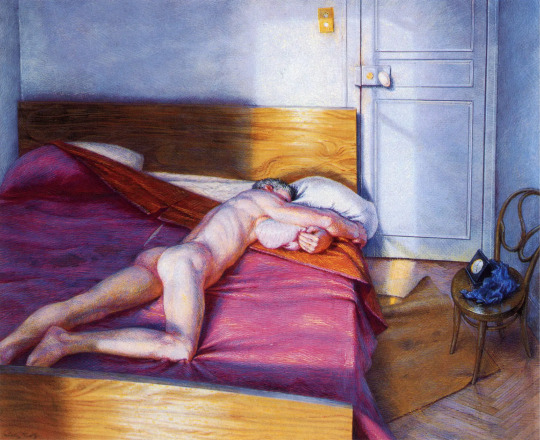
Paul Cadmus’s “The Nap” (1952)
Collection of the Tobin Theatre Arts Fund, courtesy of the McNay Art Museum, San Antonio
DC Moore Gallery
369 notes
·
View notes
Text

Audley “Queen Mother” Moore (July 27, 1898 - May 2, 1997) prominent Harlem civil rights activist, was born in New Iberia, Louisiana to Ella and St. Cry Moore. She educated herself by reading the writings of Frederick Douglass and listening to the speeches of Marcus Garvey.
Moved by the Black Nationalist message in a speech Marcus Garvey gave in New Orleans, she migrated to Harlem in 1922. She became a member and then a leader within Garvey’s Universal Negro Improvement Association. A proud shareholder in the Black Star Line, she helped organize UNIA conventions in New York. She married Frank Warner in 1922. They had one son.
After the demise of the UNIA, she founded several organizations. She founded and served as president of the Universal Association of Ethiopian Women. She founded the Committee for Reparations for Descendants of US Slaves, and The Republic of New Africa, which demanded self-determination, land, and reparations for African Americans. During the height of the Cold War, she presented a petition to the UN in 1957 which demanded land and billions in reparations for people of African descent and it requested direct support for African Americans who sought to immigrate to Africa.
She focused on local issues. She participated in a sit-in at a Board of Education meeting in Brooklyn. She and the other protesters said board members failed to adequately fund schools in African American communities. She served as the bishop of the Apostolic Orthodox Church of Judea and she co-founded the Commission to Eliminate Racism, Council of Churches of Greater New York.
While attending the funeral of former Ghanaian President Kwame Nkrumah, the Ashanti ethnic group bestowed upon her the honorary title “Queen Mother.” The Corcoran Gallery of Art in DC. honored Moore and 40 other famous Black women in Brian Lanker’s photo exhibit, “I Dream a World.”
Her activism continued through the mid-1990s, and she made her final public appearance at the Million Man March in 1995. She was survived by her son, five grandchildren, and a great-grandson. #africanhistory365 #africanexcellence
39 notes
·
View notes
Text
Lonnie Machin/Anarky/Moneyspider: Complete (New Earth) Reading Guide
Who is Lonnie Machin?
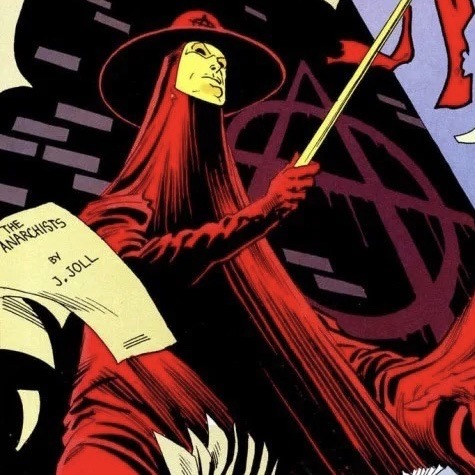
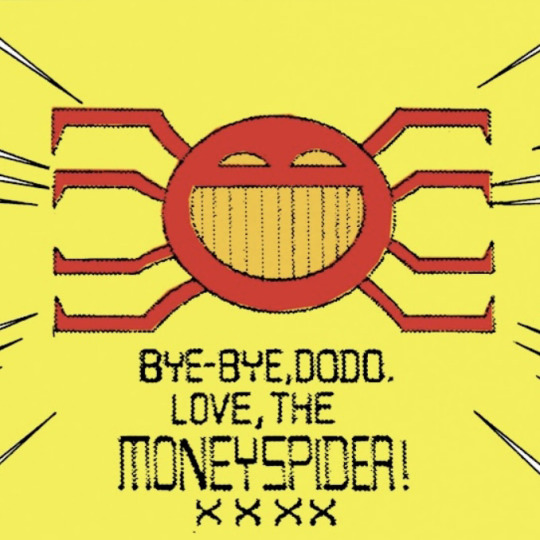
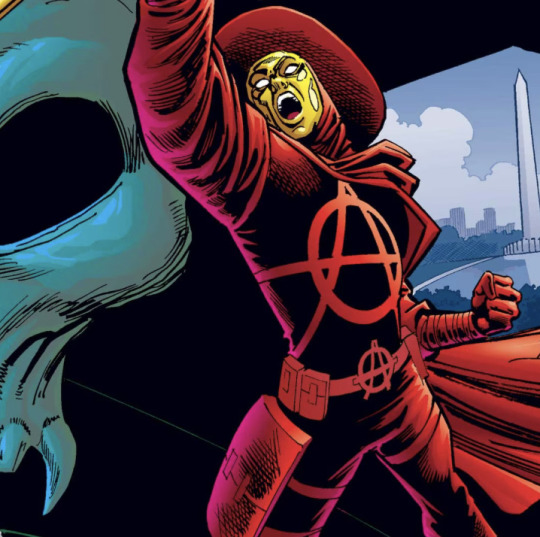
Lonnie Machin first entered the post-Crisis DC Universe in 1989 in Detective Comics (1937) Issues #608-609, written by Alan Grant and penciled by Norm Breyfogle. Inspired by the likes of V from Alan Moore's V for Vendetta and Chopper from Judge Dredd, Lonnie would become a relative thorn in the bourgeoisie (and Batman)'s side as the vigilante Anarky, the self-proclaimed 'voice of the people', until 2009. An impassioned young idealist and genius hacker/engineer, Lonnie would often be referred to as an 'anti-villain' by writers and fans alike - though he would remain outside of Batman's general rogues gallery, caring about making Gotham and the world as a whole a better place for the common man.
He would go on to star in two solo series, team up twice with Oliver Queen's Green Arrow, and eventually come to aid Tim Drake (as Red Robin) under the previously established hacker alias 'Moneyspider' from 2009 until the New 52 reboot in 2011.
What does this guide include?
Linked below is a spreadsheet including most/all of Lonnie Machin's comic appearances from his debut up to the New 52 (plus a few post-reboot recommendations). Sorted chronologically, each row features information such as title date and writer/penciller, which identity/mantle is most prominent in each appearance, personal notes on the contents of each issue, and a section for any content warnings that may need addressed.
Happy reading!
The Guide
396 notes
·
View notes
Text







Paul Cadmus: The Male Nude
February 8 – March 16, 2024
DC Moore Gallery
535 West 22nd Street, New York, NY 10011
25 notes
·
View notes
Text

Eric Aho
Stars and Fireflies Late June, 2023
Oil on linen
36 x 42 inches
Courtesy DC Moore Gallery
10 notes
·
View notes
Photo
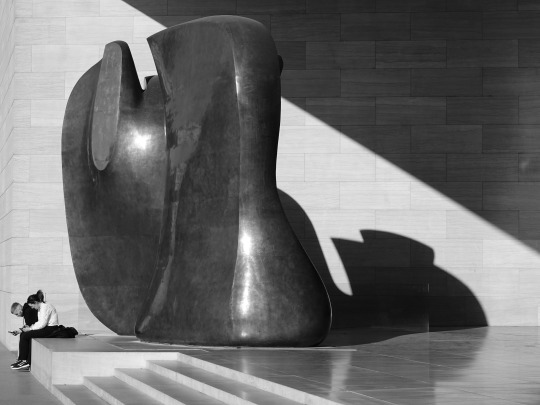
Knife Edge Mirror Two Piece, 1976-1978 - bronze
Henry Moore British, 1898 - 1986
National Gallery of Art, Washington, DC
photo: David Castenson
241 notes
·
View notes
Text


Valerie Jaudon's "Long Division" (1988) at 23 St (6) station is an intricately designed, 60-foot-long steel fence that serves as both a welcoming entry point and functional barrier. Designed with a pattern of crisscrossing arches and vertical lines, the panels form a unified set of connecting arch patterns. "The idea was to make a fence that functions as combination of wall, door, window, and column that allows you to see the entire station," Jaudon described.
Jaudon’s sustained investigation of line and pattern is on display in her solo exhibition at DC Moore Gallery. On view through November 11, the exhibition features paintings from the last two decades.
📸: Michelle Shin
26 notes
·
View notes
Text





Duane Michals - The Young Girl’s Dream, 1969
Five gelatin silver prints with hand applied text Carnegie Museum of Art, Pittsburgh Courtesy of the Artist and DC Moore Gallery
22 notes
·
View notes
Text

Self Portrait Asleep in a Tomb of Mereuka, 1978.
© Duane Michals, Courtesy of DC Moore Gallery, New York
14 notes
·
View notes
Text

Gwendolyn Knight (1913-2005), New Orleans
Silkscreen on paper
Support size: 22 x 20 inches; Image size: 16 1/2 x 14 1/2 inches
2002
16 notes
·
View notes
Note
Is it true you don't like anything from Grant Morrison, or just the man himself at all?
I don't think I've mentioned my thoughts on Grant Morrison here but I do really love Grant Morrison's early DC work, in particular Animal Man being one of my favorite comics of all time, but I find their later work to be so terrible that I consider it my least favorite comics of all time. I blame this on the running themes of Metatextuality and a sort of reconstructivist ideology in Morrison's work that has ended up completely antithetical to what i desire from comics.
While the absurdist ruminations on the nature of fiction in Animal Man made for an amazing and radical sort of comic that deconstructed a lot about both superheroes and the relationship between fiction and reality, over time their work fell into what to me feels like just very shallow and uninteresting narratives that frequently fall into the same traps as like, redditors and youtube theorists, where it doesn't really have that much to say beyond "woah... this is a work of fiction and we're breaking the fourth wall!!!!!1111" and "superheroes are actually super cool and should never be criticized". The top examples i can think of are their Batman run, which brought back several concepts but in ways that felt shallow (was it really that necessary to bring back the Batman of Zurr-En-Arrh as an edgy violent alternate personality?), meanspirited (Son of the Demon being brought into canon, but retconning Bruce and Talia's loving relationship to... that.), or even offensive (if you're going to make a modern version of the Batmen of all Nations, even if you're going to be rewriting them to attempt to make more realistic and progressive incarnations of them is it really necessary to keep the more offensive designs, and redesign others to be even more offensive? I don't think they had people of color on hand for that stuff...). Meanwhile there's the multiverse stuff that I just really can't bring myself to care about, that kind of thing is already really boring for me personally and though Morrison tries to make more meaningful narrative in them that narrative is just "Aren't superheroes really epic and cool?"
There's also the fact that regardless of being nonbinary Morrison hasn't really had the best track record when it comes to depicting minority groups. I already mentioned the Batmen of all Nations but there's them turning Talia into a misogynistic and somewhat racist stereotype, and Professor Pyg, who's Buffalo Bill-type queercoding is so offensive that I genuinely can't stomach it as a character. This is more controversial, but I feel this even about A Serious House on Serious Earth, both in the character of Mad Dog but also in the comic's general depiction of Batman's rogues' gallery not as characters of their own but as caricatures of mental illness existing primarily as foils for Batman's personal conflicts, which bled into the comics and kind of became a defining part of Batman as a franchise and its frequent usage of psychological themes.
Morrison also has a particularly unfortunate flaw in that theyre kind of... redditbrained. They're famous for their personal theory on the ending of the Killing Joke of how it actually represents Batman finally breaking his one rule and killing the Joker, despite how the comic very clearly frames the moment as the one last moment of understanding the two will ever have. There's also Morrison's idea of all Batman media being true, and justifying it as the sillier parts of Batman being caused by... him and Robin being on drugs. They've literally said that.
My main like, ideological opposition to Morrison though is in their reconstructivist themes and the way they place superheroes as like gods to be aspired to. I certainly fall closer to Moore when it comes to my perspective on comics and while I don't think they're beyond salvation Morrison simply isn't doing them any favors. I just don't want to see comics about how epic Batman and Superman are or whatever, I want to see more radical stuff that breaks down superhero comics as a whole. By all means I like seeing the weird reinvention of old concepts, but being so stuck in the past is just kind of, stupid.
#dc#txt#text#sorry this is rambly im sick as i write this and tumblr has been fucking up and blocking me from replying for like 2 days
12 notes
·
View notes
Text

Duane Michals
via: DC Moore Gallery
102 notes
·
View notes
Text

Paul Cadmus, Male Nude NMA, 1965, crayon, casein, and ink on hand toned paper, 15 x 25 in. Private Collection. Courtesy DC Moore Gallery
3 notes
·
View notes
Text

Title: Bahian Lace
Creator: David Driskell
Date Created: 1988
Copyright: © Estate of David C. Driskell, courtesy DC Moore Gallery, New York
I visited an online art exhibition from the Cincinnati Art Museum, and I saw this image which caught my eye immediately.
The theme of the exhibition is "Homeage: What was, is, to come". Here is the introduction of this image
David Driskell, an expressionist of nature and culture, spent his life centering his work around things he saw. Much of it represents a long-standing connection between African American history, the lands where those histories intersect and rest, spirituality, and acknowledgment of the land where he felt most free. He, like most artists, allowed his work to reflect his experience in those current moments, stamping his innermost thoughts and feelings at the time of creation. He refers to his desire to create artwork as a “spiritual urge within to fulfill (his) earthly task of making and creating (his) own beautiful world”.
This is an oil and collage on canvas piece, that deeply connects with African and African-American cultures. Driskell’s use of vibrant colors and intricate patterns often relates to traditional African textiles, making his work visually striking and culturally meaningful. He creatively blends these elements to tell stories about identity and history, offering a visual exploration of the African diaspora’s influence on art.
4 notes
·
View notes